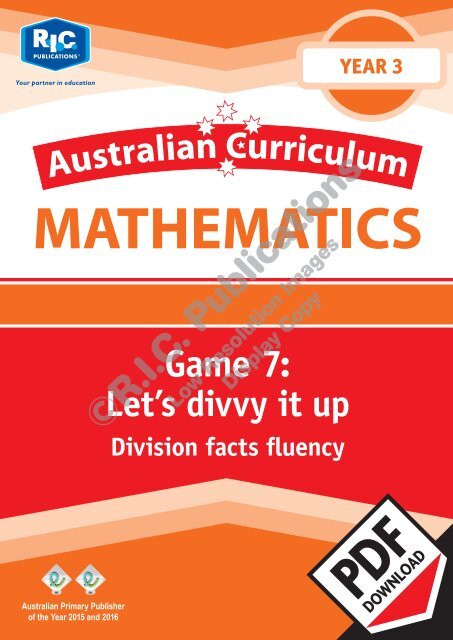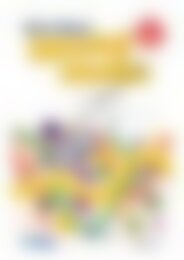RIC-20326_Maths_games_for_the_Australian_Curriculum_Year_3_Game_7_Division_facts_fluency
Create successful ePaper yourself
Turn your PDF publications into a flip-book with our unique Google optimized e-Paper software.
©R.I.C. Publications<br />
Low Resolution Images<br />
Display Copy
<strong>Maths</strong> <strong>games</strong> <strong>for</strong> <strong>the</strong> <strong>Australian</strong> <strong>Curriculum</strong> (Book 2)<br />
Published by R.I.C. Publications ® 2014 under licence from Didax Inc.<br />
Copyright © Gail Gerdemann with Kathleen Barta 2014<br />
<strong>RIC</strong>–<strong>20326</strong><br />
All material identified by is material subject to<br />
copyright under <strong>the</strong> Copyright Act 1968 (Cth) and is owned<br />
by <strong>the</strong> <strong>Australian</strong> <strong>Curriculum</strong>, Assessment and Reporting<br />
Authority 2014.<br />
For all <strong>Australian</strong> <strong>Curriculum</strong> material except<br />
elaborations: This is an extract from <strong>the</strong> <strong>Australian</strong><br />
<strong>Curriculum</strong>.<br />
Elaborations: This may be a modified extract from <strong>the</strong><br />
<strong>Australian</strong> <strong>Curriculum</strong> and may include <strong>the</strong> work of o<strong>the</strong>r<br />
authors.<br />
Disclaimer: ACARA nei<strong>the</strong>r endorses nor verifies <strong>the</strong><br />
accuracy of <strong>the</strong> in<strong>for</strong>mation provided and accepts no<br />
responsibility <strong>for</strong> incomplete or inaccurate in<strong>for</strong>mation. In<br />
particular, ACARA does not endorse or verify that:<br />
• The content descriptions are solely <strong>for</strong> a particular year<br />
and subject;<br />
• All <strong>the</strong> content descriptions <strong>for</strong> that year and subject<br />
have been used; and<br />
• The author’s material aligns with <strong>the</strong> <strong>Australian</strong><br />
<strong>Curriculum</strong> content descriptions <strong>for</strong> <strong>the</strong> relevant year<br />
and subject.<br />
You can find <strong>the</strong> unaltered and most up to date version of<br />
this material at<br />
http://www.australiancurriculum.edu.au/<br />
This material is reproduced with <strong>the</strong> permission of ACARA.<br />
Copyright Notice<br />
A number of pages in this book are<br />
worksheets. The publisher licenses <strong>the</strong><br />
individual teacher who purchased this<br />
book to photocopy <strong>the</strong>se pages to hand<br />
out to students in <strong>the</strong>ir own classes.<br />
Except as allowed under <strong>the</strong> Copyright Act<br />
1968, any o<strong>the</strong>r use (including digital and<br />
online uses and <strong>the</strong> creation of overhead<br />
transparencies or posters) or any use by<br />
or <strong>for</strong> o<strong>the</strong>r people (including by or <strong>for</strong><br />
o<strong>the</strong>r teachers, students or institutions)<br />
is prohibited. If you want a licence to<br />
do anything outside <strong>the</strong> scope of <strong>the</strong><br />
BLM licence above, please contact <strong>the</strong><br />
Publisher.<br />
This in<strong>for</strong>mation is provided to clarify <strong>the</strong><br />
limits of this licence and its interaction<br />
with <strong>the</strong> Copyright Act.<br />
For your added protection in <strong>the</strong> case of<br />
copyright inspection, please complete <strong>the</strong><br />
<strong>for</strong>m below. Retain this <strong>for</strong>m, <strong>the</strong> complete<br />
original document and <strong>the</strong> invoice or<br />
receipt as proof of purchase.<br />
Name of Purchaser:<br />
Date of Purchase:<br />
Supplier:<br />
School Order# (if applicable):<br />
Signature of Purchaser:<br />
©R.I.C. Publications<br />
Low Resolution Images<br />
Display Copy<br />
Internet websites<br />
In some cases, websites or specific URLs may be recommended. While <strong>the</strong>se are checked and rechecked at <strong>the</strong> time of publication,<br />
<strong>the</strong> publisher has no control over any subsequent changes which may be made to webpages. It is strongly recommended that <strong>the</strong> class<br />
teacher checks all URLs be<strong>for</strong>e allowing students to access <strong>the</strong>m.<br />
View all pages online<br />
PO Box 332 Greenwood Western Australia 6924<br />
Website: www.ricpublications.com.au<br />
Email: mail@ricgroup.com.au
Foreword<br />
Students are more engaged when <strong>the</strong>y are having fun, and <strong>the</strong> collection of activities will improve student<br />
understanding and streng<strong>the</strong>n skills through lively, collaborative and interactive <strong>games</strong>.<br />
<strong>Game</strong>s assist students with computational <strong>fluency</strong> and greater conceptual understanding as each in-depth unit<br />
includes warm-up activities, one or more <strong>games</strong>, ideas <strong>for</strong> differentiation and develops ma<strong>the</strong>matical capabilities.<br />
Contents<br />
Teachers notes .................................... iv – vi<br />
<strong>Curriculum</strong> links ......................................... vii<br />
Strategies <strong>for</strong> developing <strong>fluency</strong> with<br />
multiplication within 100<br />
<strong>Game</strong> 1 Double trouble<br />
Multiplying by twos and fours................ 2–11<br />
<strong>Game</strong> 2 Think about ten<br />
Multiplying by tens, fives, and nines.... 12–21<br />
<strong>Game</strong> 3 Triple trouble<br />
Multiplying by threes and sixes............ 22–30<br />
<strong>Game</strong> 4 Using <strong>facts</strong> you know<br />
Multiplying by sevens and eights ....... 31–37<br />
<strong>Game</strong> 5 Putting it all toge<strong>the</strong>r<br />
Multiplication <strong>facts</strong> <strong>fluency</strong> ................. 38–41<br />
Place value understanding and properties of<br />
operations – Multi-digit arithmetic<br />
<strong>Game</strong> 8 Let’s get a-round to it<br />
Rounding.............................................. 51–55<br />
<strong>Game</strong> 9 The multiples of ten<br />
Multiply by multiples of ten................. 56–59<br />
<strong>Game</strong> 10 That’s ‘sum’ difference<br />
Add/Subtract within<br />
1000 – Fluency...................................... 60–64<br />
©R.I.C. Publications<br />
Low Resolution Images<br />
Display Copy<br />
Develop understanding of equivalent<br />
fractions and compare fractions<br />
<strong>Game</strong> 11 Match <strong>the</strong> fractions<br />
Equivalent fractions.............................. 65–68<br />
Relationship of multiplication/division and<br />
<strong>fluency</strong> with division within 100<br />
<strong>Game</strong> 6 Is that a fact?<br />
Relationship of<br />
multiplication/division......................... 42–46<br />
<strong>Game</strong> 12 Wild card fractions<br />
Comparisons of fractions.................... 69–72<br />
Reproducibles .............................. 73–113<br />
<strong>Game</strong> 7 Let’s divvy it up<br />
<strong>Division</strong> <strong>facts</strong> <strong>fluency</strong>............................ 47–50<br />
www.ricpublications.com ©<strong>RIC</strong> Publications<br />
www.ricpublications.com.au R.I.C. Publications ®<br />
<strong>Maths</strong> <strong>games</strong> <strong>for</strong> <strong>Australian</strong> <strong>Curriculum</strong> Book 2<br />
<strong>Maths</strong> <strong>games</strong> <strong>for</strong> <strong>the</strong> <strong>Australian</strong> <strong>Curriculum</strong> iii<br />
iii
Teachers notes<br />
Introduction<br />
<strong>Maths</strong> <strong>games</strong> <strong>for</strong> <strong>the</strong> <strong>Australian</strong> <strong>Curriculum</strong> series targets:<br />
• Operations and algebraic thinking<br />
• Number and operations in Base Ten<br />
• Number and operations—fractions<br />
These <strong>games</strong> are designed to help students understand key concepts and streng<strong>the</strong>n skills.<br />
Developing number sense can take time. We all know that students are more engaged when<br />
<strong>the</strong>y are having fun, and <strong>the</strong>se <strong>games</strong> are designed <strong>for</strong> both substance and fun.<br />
The <strong>games</strong> and activities program is also designed to be straight<strong>for</strong>ward <strong>for</strong> teachers.<br />
Supplies include standard equipment like paperclips and coloured markers, as well as copies<br />
of blackline masters. All materials <strong>for</strong> <strong>the</strong> year may be duplicated and organised in about<br />
one hour. Basic manipulatives such as tiles and fraction pieces are recommended but not<br />
required.<br />
Each game provides:<br />
• Ideas <strong>for</strong> more support and some challenges<br />
• Discussion questions to help students make connections between <strong>the</strong> game and<br />
ma<strong>the</strong>matical concepts<br />
• Straight<strong>for</strong>ward directions<br />
• Blackline masters<br />
These <strong>games</strong> can also be used <strong>for</strong> home-school activities.<br />
Materials<br />
Step 1: Duplicate blackline masters and place <strong>the</strong>m in file folders.<br />
Step 2: Duplicate cards* on card stock; cut out <strong>the</strong> cards.<br />
Step 3: Ga<strong>the</strong>r <strong>the</strong> recommended manipulatives.<br />
©R.I.C. Publications<br />
Low Resolution Images<br />
Display Copy<br />
* Number cards (0–9): Regular playing cards may be substituted. Remove Kings, Jacks and<br />
10s. Use <strong>the</strong> Ace as 1 and <strong>the</strong> Queens as zero. (‘Q’ looks similar to ‘O’).<br />
* Fraction cards: Only <strong>the</strong> eighths cards are required but o<strong>the</strong>rs are recommended.<br />
Student-created fraction cards may be substituted.<br />
www.ricpublications.com.au R.I.C. Publications ®<br />
<strong>Maths</strong> <strong>games</strong> <strong>for</strong> <strong>the</strong> <strong>Australian</strong> <strong>Curriculum</strong><br />
v
<strong>Curriculum</strong> links<br />
Content descriptions<br />
Overview of <strong>games</strong> and activities<br />
<strong>Year</strong> 2<br />
Investigate number sequences, initially those increasing and decreasing<br />
by twos, threes, fives and ten from any starting point, <strong>the</strong>n moving to<br />
o<strong>the</strong>r sequences. (ACMNA026)<br />
Recognise, model, represent and order numbers to at least 1000<br />
(ACMNA027)<br />
Group, partition and rearrange collections up to 1000 in hundreds, tens<br />
and ones to facilitate more efficient counting (ACMNA028)<br />
<strong>Game</strong>s<br />
1 2 3 4 5 6 7 8 9 10 11 12<br />
– – – – – – – –<br />
– – – – – – – – – – –<br />
– – – – – – – – – –<br />
Explore <strong>the</strong> connection between addition and subtraction (ACMNA029) – – – – – – – – – –<br />
Solve simple addition and subtraction problems using a range of<br />
efficient mental and written strategies (ACMNA030)<br />
Recognise and represent multiplication as repeated addition, groups<br />
and arrays (ACMNA031)<br />
Recognise and represent division as grouping into equal sets and solve<br />
simple problems using <strong>the</strong>se representations (ACMNA032)<br />
Recognise and interpret common uses of halves, quarters and eighths of<br />
shapes and collections (ACMNA033)<br />
– – – –<br />
– – – –<br />
– – – – – – – – – – –<br />
– – – – – – – – – –<br />
EXTENSION – – – – – – – – – –<br />
<strong>Year</strong> 3<br />
Investigate <strong>the</strong> conditions required <strong>for</strong> a number to be odd or even and<br />
identify odd and even numbers (ACMNA051)<br />
Apply place value to partition, rearrange and regroup numbers to at<br />
least 10 000 to assist calculations and solve problems (ACMNA053)<br />
Recognise and explain <strong>the</strong> connection between addition and<br />
subtraction (ACMNA054)<br />
– – – – – – – – – –<br />
©R.I.C. Publications<br />
Low Resolution Images<br />
Display Copy<br />
– – – – – – – – – – –<br />
– – – – – – – – – – –<br />
Recall addition <strong>facts</strong> <strong>for</strong> single-digit numbers and related subtraction<br />
<strong>facts</strong> to develop increasingly efficient mental strategies <strong>for</strong> computation<br />
(ACMNA055)<br />
Recall multiplication <strong>facts</strong> of two, three, five and ten and related division<br />
<strong>facts</strong> (ACMNA056)<br />
Represent and solve problems involving multiplication using efficient<br />
mental and written strategies and appropriate digital technologies<br />
(ACMNA057)<br />
Model and represent unit fractions including 1 ⁄2, 1 ⁄4, 1 ⁄3, 1 ⁄5 and <strong>the</strong>ir<br />
multiples to a complete whole (ACMNA058)<br />
– – – – – – – – – – –<br />
– – – – –<br />
– – – – –<br />
– – – – – – – – – –<br />
EXTENSION – – – – – – – – – – –<br />
www.ricpublications.com.au R.I.C. Publications ®<br />
<strong>Maths</strong> <strong>games</strong> <strong>for</strong> <strong>the</strong> <strong>Australian</strong> <strong>Curriculum</strong><br />
vvv
Let’s divvy it up<br />
<strong>Game</strong> 7<br />
Fluently divide within 100, using strategies such as <strong>the</strong> relationship between<br />
multiplication and division or properties of operations.<br />
Ma<strong>the</strong>matical understanding and skills<br />
Fluently multiply within 100, using strategies such as <strong>the</strong> relationship between multiplication<br />
and division or properties of operations.<br />
Prerequisite skills<br />
Students should have strategies <strong>for</strong> multiplying all <strong>facts</strong> within 100, but may not yet have<br />
automaticity <strong>for</strong> all <strong>facts</strong>.<br />
<strong>Maths</strong> vocabulary<br />
dividend<br />
divisor<br />
quotient<br />
Materials<br />
For each pair of students:<br />
• ‘Divide by …’ spinners A, B & C (pages 92–94)<br />
• Multiplication chart (page 105)<br />
• Deck of number cards 1–9 (page 104)<br />
• Product/Divisor cards (pages 106–107)<br />
• ‘Let’s divvy it up’ game board (page 95)<br />
Warm-up<br />
‘Let’s divvy it up’<br />
game<br />
©R.I.C. Publications<br />
Low Resolution Images<br />
Display Copy<br />
16 3<br />
54 6<br />
21 30<br />
42 9<br />
48 36<br />
24 24<br />
12 18<br />
42 27<br />
www.ricpublications.com.au R.I.C. Publications ®<br />
<strong>Maths</strong> <strong>games</strong> <strong>for</strong> <strong>the</strong> <strong>Australian</strong> <strong>Curriculum</strong><br />
44
Let’s divvy it up<br />
<strong>Game</strong> 7<br />
Warm-up: Divide by …<br />
Number of players: 2<br />
Materials:<br />
For each pair of students:<br />
• ‘Divide by …’ spinners A, B and C (pages 92–94)<br />
• Multiplication chart (page 105)<br />
Object: Get 16 or more quotients right out of 20 spins <strong>for</strong> each spinner.<br />
Directions:<br />
1. Pick a spinner. (Teacher assigns or students choose.)<br />
2. Spin <strong>for</strong> <strong>the</strong> dividend.<br />
3. Divide by <strong>the</strong> divisor <strong>for</strong> that spinner.<br />
4. Each player writes <strong>the</strong> quotient.<br />
5. Players compare <strong>the</strong>ir quotients. Check using <strong>the</strong> multiplication chart, if needed. If both<br />
are correct, circle <strong>the</strong> quotient.<br />
6. Spin again. Do 20 spins. If players get 16 correct out of 20, it’s time <strong>for</strong> a new spinner.<br />
12<br />
18<br />
3<br />
21 15<br />
27<br />
9<br />
÷ 3<br />
6 24<br />
©R.I.C. Publications<br />
Low Resolution Images<br />
Display Copy<br />
63<br />
35<br />
7<br />
56<br />
÷ 7<br />
14 28<br />
42 49<br />
21<br />
44 <strong>Maths</strong> <strong>games</strong> <strong>for</strong> <strong>the</strong> <strong>Australian</strong> <strong>Curriculum</strong> www.ricpublications.com.au<br />
R.I.C. Publications ®
Let’s divvy it up<br />
<strong>Game</strong> 7<br />
Explaining <strong>the</strong> game<br />
Number of players: 2<br />
Materials:<br />
For each pair of students:<br />
• Deck of number cards 2–9 (remove <strong>the</strong> 5), called ‘divisor cards’ in this game<br />
(page 104)<br />
• One set of product/divisor cards, called ‘dividend cards’ in this game<br />
(pages 106–107)<br />
• <strong>Game</strong> board (page 95)<br />
Object: Win cards by making division <strong>facts</strong>.<br />
How to play:<br />
1. Place <strong>the</strong> divisor and dividend card decks on <strong>the</strong> game board. Place one divisor card<br />
face up.<br />
2. Players take turns dividing <strong>the</strong> dividend by <strong>the</strong> divisor, if possible.<br />
3. If <strong>the</strong> cards can be used to make a division fact (<strong>for</strong> example, 42 and 6), <strong>the</strong> player says<br />
<strong>the</strong> fact: ‘42 divided by 6 equals 7’. If correct, <strong>the</strong> player puts <strong>the</strong> dividend card in his/<br />
her ‘win pile’. Then it is <strong>the</strong> o<strong>the</strong>r player’s turn.<br />
4. If <strong>the</strong> cards cannot be used to make a division fact, <strong>the</strong> player whose turn it is draws a<br />
new divisor card and divides. If <strong>the</strong> new cards cannot be used, <strong>the</strong> player’s turn is over.<br />
5. Play continues until all of <strong>the</strong> dividend cards are used. The winner is <strong>the</strong> player with <strong>the</strong><br />
most cards.<br />
©R.I.C. Publications<br />
Low Resolution Images<br />
Display Copy<br />
Variation<br />
The same rules as ‘Let’s divvy it up’, except: A player may collect any dividend<br />
card that is a square number at <strong>the</strong> beginning of his/her turn, even if he/she<br />
does not have <strong>the</strong> divisor card. The player just has to correctly identify its factors.<br />
www.ricpublications.com.au R.I.C. Publications ®<br />
<strong>Maths</strong> <strong>games</strong> <strong>for</strong> <strong>the</strong> <strong>Australian</strong> <strong>Curriculum</strong><br />
44
Let’s divvy it up<br />
<strong>Game</strong> 7<br />
Differentiation<br />
Warm-up: Divide by . . .<br />
Challenge<br />
• Play a divide-withremainders<br />
version: Pick any<br />
spinner. Use <strong>the</strong> divisor cards<br />
2–9. Spin <strong>for</strong> <strong>the</strong> dividend. Turn<br />
over a card <strong>for</strong> <strong>the</strong> divisor.<br />
What is <strong>the</strong> quotient? Is <strong>the</strong>re a<br />
remainder?<br />
Ask <strong>the</strong> class<br />
It is possible to:<br />
• Share an odd number of items with an even number of<br />
people?<br />
• Share an even number of items with an odd number of<br />
people?<br />
• Share an odd number of items with an odd number of<br />
people?<br />
• Share an even number of items with an even number of<br />
people?<br />
• Put an odd number of items evenly into an odd number<br />
of groups; <strong>for</strong> example, 25 items into 5 or 7 groups?<br />
(Sometimes it is, sometimes it isn’t.)<br />
Give examples <strong>for</strong> each.<br />
Do you agree or disagree? Why?<br />
Let’s divvy it up game<br />
More support<br />
Deepening <strong>the</strong> understanding<br />
• Additional time with <strong>the</strong> warm-up<br />
exercise can provide an opportunity to<br />
develop <strong>fluency</strong> with each of <strong>the</strong> divisors.<br />
• Begin by using just <strong>the</strong> product/divisor<br />
cards 12, 14, 16, 18, 21, 24, 27, 28, 32 and 36.<br />
• Have <strong>the</strong> multiplication chart available<br />
facedown to check answers as needed.<br />
Ma<strong>the</strong>matical capabilities<br />
Reason abstractly and quantitatively.<br />
Construct viable arguments and critique <strong>the</strong><br />
reasoning of o<strong>the</strong>rs.<br />
©R.I.C. Publications<br />
Low Resolution Images<br />
Display Copy<br />
For a dividend of 24, what are possible divisor/quotient pairs?<br />
What are o<strong>the</strong>r dividends in <strong>the</strong> multiplication chart that have<br />
more than one divisor/quotient pair?<br />
Reason abstractly and quantitatively.<br />
Construct viable arguments and critique <strong>the</strong><br />
reasoning of o<strong>the</strong>rs.<br />
55 <strong>Maths</strong> <strong>games</strong> <strong>for</strong> <strong>the</strong> <strong>Australian</strong> <strong>Curriculum</strong> www.ricpublications.com.au<br />
R.I.C. Publications ®
Let’s divvy it up<br />
<strong>Game</strong> 7<br />
‘Divide by …’ spinner A<br />
Spinner <strong>for</strong> <strong>the</strong> divisor ‘2’ Spinner <strong>for</strong> <strong>the</strong> divisor ‘3’<br />
2 10<br />
16<br />
6<br />
8<br />
÷ 2<br />
14<br />
Spinner <strong>for</strong> <strong>the</strong> divisor ‘4’ Spinner <strong>for</strong> <strong>the</strong> divisor ‘5’<br />
4 28<br />
20<br />
18<br />
12<br />
9<br />
12 18<br />
21 15<br />
4<br />
27<br />
12 30<br />
35<br />
5<br />
3<br />
÷ 3<br />
6 24<br />
20<br />
©R.I.C. Publications<br />
Low Resolution Images<br />
Display Copy<br />
÷ 4<br />
36 24<br />
16 8<br />
32<br />
÷ 5<br />
45 10<br />
15 25<br />
40<br />
99 <strong>Maths</strong> <strong>games</strong> <strong>for</strong> <strong>the</strong> <strong>Australian</strong> <strong>Curriculum</strong> www.ricpublications.com.au<br />
R.I.C. Publications ®
Let’s divvy it up<br />
<strong>Game</strong> 7<br />
‘Divide by …’ spinner B<br />
Spinner <strong>for</strong> <strong>the</strong> divisor ‘6’ Spinner <strong>for</strong> <strong>the</strong> divisor ‘7’<br />
36 6<br />
24<br />
30<br />
42<br />
÷ 6<br />
12<br />
Spinner <strong>for</strong> <strong>the</strong> divisor ‘8’ Spinner <strong>for</strong> <strong>the</strong> divisor ‘9’<br />
8<br />
72<br />
35<br />
63<br />
56<br />
18 54<br />
42 49<br />
48<br />
21<br />
54 9<br />
24<br />
40 27<br />
36<br />
7<br />
÷ 7<br />
14 28<br />
©R.I.C. Publications<br />
Low Resolution Images<br />
Display Copy<br />
56<br />
÷ 8<br />
16<br />
32 64<br />
48<br />
81<br />
÷ 9<br />
72<br />
45 18<br />
63<br />
www.ricpublications.com.au R.I.C. Publications ®<br />
<strong>Maths</strong> <strong>games</strong> <strong>for</strong> <strong>the</strong> <strong>Australian</strong> <strong>Curriculum</strong><br />
99
Let’s divvy it up<br />
<strong>Game</strong> 7<br />
‘Divide by …’ spinner C<br />
Spinner <strong>for</strong> divisor ‘4’ or ‘8’<br />
4 28<br />
32 24<br />
16 8<br />
72 56<br />
20 12<br />
36 48<br />
32 64<br />
24 40<br />
Spinner <strong>for</strong> divisor ‘3’ or ‘6’<br />
15 3<br />
54 6<br />
21 30<br />
Can you divide by 4 and<br />
get a 1-digit quotient?<br />
or<br />
Can you divide by 8 and<br />
get a 1-digit quotient?<br />
©R.I.C. Publications<br />
Low Resolution Images<br />
Display Copy<br />
42 9<br />
48 36<br />
24 24<br />
Can you divide by 3 and<br />
get a 1-digit quotient?<br />
or<br />
Can you divide by 6 and<br />
get a 1-digit quotient?<br />
12 18<br />
42 27<br />
99 <strong>Maths</strong> <strong>games</strong> <strong>for</strong> <strong>the</strong> <strong>Australian</strong> <strong>Curriculum</strong> www.ricpublications.com.au<br />
R.I.C. Publications ®
Let’s divvy it up<br />
<strong>Game</strong> 7<br />
<strong>Game</strong> board<br />
÷ Divisor<br />
=<br />
card,<br />
face up<br />
Deck of<br />
dividend<br />
cards,<br />
face up<br />
dividend divisor quotient<br />
©R.I.C. Publications<br />
Low Resolution Images<br />
Display Copy<br />
Deck of<br />
divisor<br />
cards,<br />
face<br />
down<br />
www.ricpublications.com.au R.I.C. Publications ®<br />
<strong>Maths</strong> <strong>games</strong> <strong>for</strong> <strong>the</strong> <strong>Australian</strong> <strong>Curriculum</strong><br />
99
0–10 number cards<br />
0<br />
4<br />
1 2<br />
5 6<br />
©R.I.C. Publications<br />
Low Resolution Images<br />
Display Copy<br />
3<br />
7<br />
8 9<br />
10<br />
111 <strong>Maths</strong> <strong>games</strong> <strong>for</strong> <strong>the</strong> <strong>Australian</strong> <strong>Curriculum</strong> www.ricpublications.com.au<br />
R.I.C. Publications ®
Multiplication chart<br />
x 0 1 2 3 4 5 6 7 8 9 10<br />
0 0 0 0 0 0 0 0 0 0 0 0<br />
1 0 1 2 3 4 5 6 7 8 9 10<br />
2 0 2 4 6 8 10 12 14 16 18 20<br />
3 0 3 6 9 12 15 18 21 24 27 30<br />
4 0 4 8 12 16 20 24 28 32 36 40<br />
5 0 5 10 15 20 25 30 35 40 45 50<br />
6 0 6 12 18 24 30 36 42 48 54 60<br />
©R.I.C. Publications<br />
Low Resolution Images<br />
Display Copy<br />
7 0 7 14 21 28 35 42 49 56 63 70<br />
8 0 8 16 24 32 40 48 56 64 72 80<br />
9 0 9 18 27 36 45 54 63 72 81 90<br />
10 0 10 20 30 40 50 60 70 80 90 100<br />
www.ricpublications.com.au R.I.C. Publications ®<br />
<strong>Maths</strong> <strong>games</strong> <strong>for</strong> <strong>the</strong> <strong>Australian</strong> <strong>Curriculum</strong><br />
111
12<br />
24<br />
14<br />
27<br />
16<br />
28<br />
18<br />
32<br />
21<br />
36<br />
Product/Divisor cards – 1<br />
©R.I.C. Publications<br />
Low Resolution Images<br />
Display Copy<br />
111 <strong>Maths</strong> <strong>games</strong> <strong>for</strong> <strong>the</strong> <strong>Australian</strong> <strong>Curriculum</strong> www.ricpublications.com.au<br />
R.I.C. Publications ®
36<br />
56<br />
42<br />
63<br />
48<br />
64<br />
49<br />
72<br />
54<br />
81<br />
Product/Divisor cards – 2<br />
©R.I.C. Publications<br />
Low Resolution Images<br />
Display Copy<br />
www.ricpublications.com.au R.I.C. Publications ®<br />
<strong>Maths</strong> <strong>games</strong> <strong>for</strong> <strong>the</strong> <strong>Australian</strong> <strong>Curriculum</strong><br />
111


















